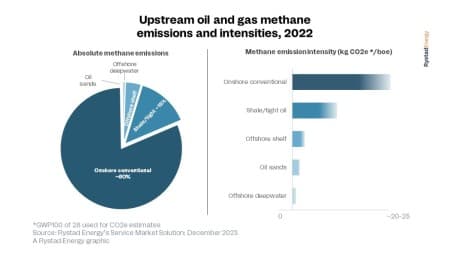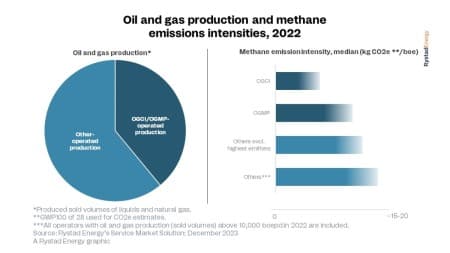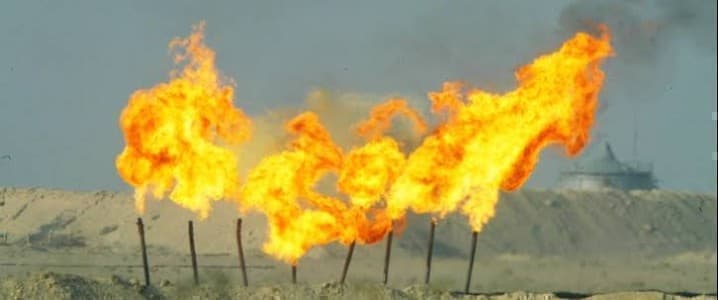Global methane emissions could be cut by tens of millions of tonnes within a single year – if oil and gas producers target the world’s top methane-emitting oil and gas fields. A recent study conducted by Rystad Energy, employing satellite detection and field-level data analysis on upstream oil and gas methane (CH4) emissions, has unveiled that more than 100 individual oil and gas fields, primarily located in the Middle East, Africa and Asia, contributed less than 1% of global production while emitting significant amounts of methane — nearly 100 million tonnes of CO2 equivalent in 2022.
Methane emissions from the energy sector have moved high up on the agenda among governments, operators, and other stakeholders such as investors in the past couple of years. Methane is considered the second-biggest contributor to climate change, and since the gas is a potent air pollutant with high global warming potential, it has to be tackled in the short term to help prevent the much-discussed climate tipping points. Recent developments in measurement technologies, such as satellite imagery, reveal that methane emissions probably are substantially higher than earlier anticipated. In addition to being a climate threat, venting and leakages of methane are also a waste of valuable resources that in most cases can be avoided. As a result, measures to limit methane emissions are gaining increasing attention across the industry.
Methane emissions were high on the agenda during the recent COP28 climate conference, and several promising announcements have been made by the energy industry, such as the Oil & Gas Decarbonization Charter (OGDC) – an agreement signed by 50 operators which together account for around 40% of global oil production to reach near-zero methane emissions by 2030. Several companies have also joined the Oil and Gas Methane Partnership (OGMP), while the Global Methane Pledge has welcomed new countries and secured new funding. Related: Security Concerns in Red Sea Boost U.S. Oil Appeal
Rystad Energy’s assessment indicates that more than half of the global upstream oil and gas methane emissions stem from large venting and leakage events, with the remaining portion attributed to flaring sources, fugitive emissions from equipment, and smaller venting occurrences. The Middle East and North America together account for nearly half of worldwide methane emissions from upstream oil and gas activities, followed by Asia, Russia, and Africa.
By contrast, South America and Europe have relatively moderate methane emissions compared to other major producing regions in the context of upstream oil and gas. While Europe’s direct upstream methane emissions are low, the region’s significant reliance on imported oil and gas—constituting about 80% of its consumption—results in a substantial methane footprint. This forms the backdrop for the announced EU regulations, which is an important step forward for tackling methane emissions in the global oil and gas value chain. From January 2027, new contracts for imported oil, gas and coal can only be concluded if exporters comply with the same monitoring, reporting, and verification obligations as EU producers. These regulations will also establish methane thresholds to govern the acceptability of hydrocarbon imports into the EU.
“Reducing methane emissions is generally a more low-hanging fruit than cutting emissions of carbon dioxide, and therefore has the most promising potential for the energy sector in the short and medium term – provided the emissions are detected. Scarce and low-quality methane data is one of the key challenges to curb methane emissions. The trend over the past couple of years has been positive as more operators deploy on-site methane monitoring equipment and use other measurement technologies such as aviation and satellites – but even so, most reported data is still based on simple emission factors for facilities and equipment located on site. Addressing the critical hurdle of limited and unreliable methane data is vital in unlocking progress for reducing methane to near zero in the short and medium term,” says Magnus Kjemphol Lohne, senior vice president of global emissions research at Rystad Energy.

Some countries are dominated by large venting events, such as several North African nations, while others have sources that are more widely scattered and generally lower in volume. The United States is an example of the latter, where widely spread emissions create a different kind of challenge and abatement and decarbonization strategies need to be structured accordingly.
Methane emissions pose specific challenges across different supply segments. About 80% of methane emissions from upstream activities originate from conventional onshore fields, followed by shale or tight oil developments, primarily in the US and Canada. The remaining emissions come from offshore and oil sands. The dominance of methane emissions from onshore conventional fields is partly influenced by the extensive volumes of onshore production, comprising about half of global output in 2022.
In terms of methane intensity, onshore operations on average have significantly higher levels than other supply segments, while offshore production has a lower methane footprint than the global average, especially deepwater developments. The lower volumes of methane emissions from offshore deepwater operations can be attributed to factors such as technology, scale, and subsurface conditions. Modern offshore platforms often feature improved methane monitoring and equipment systems, resulting in generally lower leakage volumes. Additionally, deepwater fields tend to have relatively low flaring.
Rystad Energy’s research indicates that exploration and production companies belonging to collaborative methane-reduction groups have lower methane emission intensities from their upstream oil and gas activities on average. By analyzing field-level methane emissions for companies that are part of the Oil and Gas Climate Initiative (OGCI) – 12 large producers accounting for one-third of global production – and the members of the Oil and Gas Methane Partnership (OGMP), we see that they on average were significantly below other companies in 2022.

Our analysis also indicates that a handful of companies are responsible for pulling up the emission figures for producers that are not members of OGCI or OGMP. When excluding the top 10% of these emitters – mainly African, Asian, and Middle Eastern operators with 2-3% of global production – the difference between the non-affiliated companies and the OGMP members narrows. This indicates that OGMP companies have addressed some of the worst practices when it comes to methane emissions, while the dozen OGCI members seem to have achieved deeper decarbonization cuts for methane.
This comparison focuses on operated assets, where the companies can directly impact their emissions. When we include non-operated fields and consider equite shares instead, the differences between OGCI/OGMP and non-affiliated operators diminish. This suggests that lower methane emissions primarily occur when companies have direct operational control over assets.

By Rystad Energy
More Top Reads From Oilprice.com:
- Security Concerns in Red Sea Boost U.S. Oil Appeal
- Big Three Automakers Rebound After Turbulent 2023
- China’s Export Controls Might Trigger a U.S. Graphite Boom


















